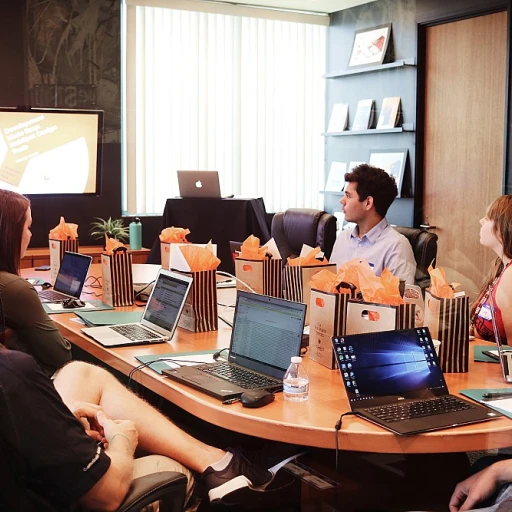
Understanding the Need for Career Development Programs
The Importance of Investing in Career Development Programs
Understanding the imperative need for career development programs within corporations involves acknowledging a rapidly changing economic landscape where skills and job roles are constantly evolving. Organizations that aspire to thrive in such an environment must facilitate and support employee career growth to ensure both individual satisfaction and overall organizational success. One pivotal aspect is recognizing that career growth should not only focus on the present but also anticipate future demands. By investing in employee development and aligning them with the company's goals, organizations pave the way for long-term success. As employees find themselves equipped with the right skills and knowledge, they become assets capable of driving the company forward. Career development programs are essential tools in creating structured learning and growth opportunities. These programs help employees map out their career paths, align with the company's strategic plans, and set realistic, yet ambitious, career goals. Additionally, having a well-established career development plan contributes to employee engagement and retention as it clearly demonstrates the company's commitment to their professional development. Tailored development plans allow employees to take ownership of their learning journeys, with access to a variety of resources such as training development and mentoring. By prioritizing career progression, organizations instill confidence within their workforce, empowering employees to aspire for diverse career paths and thus ensuring competence and adaptability. Investing in employee career development not only meets the immediate needs of the company but also acts as a cornerstone for nurturing a skilled and agile workforce. Organizations that prioritize professional growth foster a culture of continuous learning and development, promoting resilience within the business ecosystem. To learn more about enhancing workforce agility through these programs, check out the insights on succession planning tools.Identifying Key Skills for Future Growth
Pinpointing Essential Skills for Tomorrow's Workforce
Understanding the evolving landscape of career development is crucial for organizations aiming to drive growth and prepare their workforce for future demands. To create a robust career pathing framework, companies must focus on identifying key skills that align with business objectives and market trends. Identifying these skills requires meticulous analysis and strategic foresight. Companies can start by evaluating industry reports and data to identify emerging skills that will be indispensable for future roles. Consider the following strategies:- Assess market trends to understand which skills are on the rise and could become crucial over the next few years.
- Conduct a skills gap analysis within the organization to identify areas where current capabilities do not match predicted needs.
- Engage with industry experts and participate in workshops to gain insights into professional growth opportunities that can enhance employee development.
Designing a Comprehensive Program Framework
Crafting the Foundation of Professional Development Plans
Building a comprehensive program framework is pivotal in shaping effective career development initiatives within corporations. This stage involves developing a structured yet adaptable approach that aligns with the organization's long-term vision and the varied needs of its workforce. Let's delve into the critical aspects of designing such a framework. To create a robust development program, consider the following essentials:- Clarify Organizational Goals: Align the program's objectives with the company's vision and mission. Ensure that the framework supports both organizational growth and employee career goals.
- Identify Diverse Career Paths: Design career paths that offer clear progression opportunities, helping employees visualize their potential future within the organization. This also enhances employee engagement and motivation.
- Incorporate Skill-building Modules: Integrate targeted training development modules focusing on critical skills necessary for current and future roles. This includes job-specific skills and broader professional growth opportunities, aiding in career pathing.
- Define Learning Opportunities: Offer a mix of formal and informal learning opportunities—such as workshops, mentoring, and on-the-job training—that cater to different learning preferences and needs.
- Set Achievable Milestones: Develop short- and long-term career goals within the framework, providing employees with a sense of achievement and motivation to pursue continuous development.
Engaging Stakeholders and Securing Buy-In
Engaging Essential Participants for Success
Implementing an effective career development program requires a strong foundation of stakeholder engagement and secure buy-in from all levels within the organization. Engagement is a key component in ensuring that career growth opportunities are available to employees and align with both their individual career goals and the company’s objectives. First, it is crucial to involve top management, as their support can champion the initiative and provide the necessary resources. Their engagement sets the precedence for participation and indicates the organizational commitment to fostering employee development. Engaging mid-level managers is equally vital as they play a direct role in the development and management of employees. Managers should be trained on how to effectively support their teams in pursuing long-term career paths by facilitating growth opportunities through professional development plans and continuous training development. Human Resources departments should collaborate actively with both leaders and employees to tailor development programs that align with the company's vision. They can provide valuable insights into the training needs and help create a structured development framework that addresses skill gaps while promoting career progression. Lastly, employees themselves are essential stakeholders. It is important to encourage employee engagement by offering platforms for feedback and tailoring programs that reflect individual career aspirations. Employees will be more committed to their development plans when they understand how these opportunities impact their professional growth and coincide with their own career pathing. Securing buy-in from these stakeholders is a collaborative effort. An organization that incorporates continuous feedback and prioritizes communication will create an environment of trust, enabling individuals to thrive and the company to grow sustainably.Implementing and Managing the Program
Rolling Out the Career Advancement Initiative
Implementing a career development program effectively requires careful coordination and a structured approach. This is where the strategic rollout becomes crucial in ensuring the program reaches its full potential. Each stage from initiation to operation demands comprehensive planning and execution, keeping in mind the development goals and objectives of the organization.
Firstly, defining a clear implementation plan is fundamental. It involves setting realistic timelines and milestones to monitor progress. Allow employees to gradually transition into the new development paths with minimal disruption to their regular job responsibilities. Facilitate this transition by aligning the program with existing organizational structures and workflows, thereby smoothening the process.
Nurturing a Supportive Training Environment
Support plays a crucial role in helping employees embrace professional growth opportunities. Providing access to diverse training resources and platforms can catalyze skills acquisition. Encourage employees' autonomy in their development journey while offering targeted support and resources such as mentorship, workshops, and online learning opportunities.
Collaborate with department heads to identify the specific skills and competences pertinent to their teams, ensuring that the training resources reflect the growth objectives of each unit. This approach not only helps employees but also aligns career development with organizational success.
Continuous Monitoring and Employee Engagement
Ongoing monitoring and feedback mechanisms are pivotal in managing the effectiveness of the offered programs. Build a system for regular reviews and checkpoints to measure progress against set career development goals. Collect feedback from participants to gauge satisfaction and identify areas for improvement.
Maintain active engagement with employees throughout the process. Recognize achievements and provide constructive feedback to foster a culture of continuous learning and improvement. By doing so, the organization can sustain motivation and enthusiasm within its workforce, paving the way for long-term career progression and growth.
By implementing and managing the program methodically, corporations can not only create a framework for career pathing but also contribute positively to employee retention and satisfaction, eventually boosting the company’s overall success.
Evaluating and Iterating on Program Success
Measuring Success Through Impact and Feedback
Evaluating a career development program's success goes beyond tracking straightforward metrics. A comprehensive assessment should focus on the impact it has on employees, their career progression, and the organization's strategic goals. Diving into the following areas will provide valuable insights:
- Set Clear Evaluation Criteria: Organizations should assess employee engagement and their growth journey, linking back to goals identified in their personal development plans. This can be achieved by analyzing promotion rates and skill acquisition.
- Gather Employee Feedback: Regularly conducting surveys and focus groups with participants will paint a clear picture of what’s working and what needs improvement. Feedback is crucial in understanding employees' perspectives on the opportunities and support provided by the development training.
- Track Career Progression: Monitoring employees' career paths over time sheds light on the program's long-term effectiveness. Look for trends in career pathing that demonstrate increased readiness for leadership roles and more defined career goals.
- Align with Organizational Goals: The success of these programs should ultimately benefit the company’s objectives. Evaluate whether programs contribute to the fulfillment of broader organization initiatives by creating a skilled and motivated workforce.
- Iterate and Improve: Development plans should be viewed as living frameworks. Using evaluative insights, organizations can make necessary modifications to enhance professional development strategies, aligning them with future growth opportunities and employee aspirations.
For organizations aiming to create impactful career paths, systematically measuring outcomes and staying responsive to employee inputs are key to evolving successful development programs continuously. By doing so, you are not only helping employees reach their full potential but also fostering a culture of sustained professional growth and lasting organizational success.













